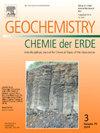Formation and age of granites and molybdenum in Shuangyangshu, NE China: Insights from UPb and ReOs geochronology geochemistry, and Hf isotopes
IF 2.9
3区 地球科学
Q2 GEOCHEMISTRY & GEOPHYSICS
引用次数: 0
Abstract
Recent research indicates that the magmatic–metallogenic events in Northeast China were mainly influenced by the tectonic regimes of the Paleo–Asian Ocean and the Paleo–Pacific Ocean. Nonetheless, significant challenges remain in comprehending the petrogenesis and source regions of the mineralizing magmas for metallogenic event. This study examines the geological chronology and geochemical data of ore–bearing granites and molybdenite from the Shuangyangshu molybdenum deposit in central Jilin. The objective is to ascertain their petrogenetic and metallogenic ages, petrogenesis, magmatic activity, and their implications for the geodynamic evolution of central Jilin. LA–ICP–MS zircon U![]() Pb dating reveals that the Shuangyangshu K–feldspar granite has an age of 179 Ma, and the monzogranite has an age of 178 Ma, indicating that they are synchronous phase change granites. Re
Pb dating reveals that the Shuangyangshu K–feldspar granite has an age of 179 Ma, and the monzogranite has an age of 178 Ma, indicating that they are synchronous phase change granites. Re![]() Os isotopic analysis of molybdenite indicates a metallogenic age of 176.3 Ma for the Shuangyangshu molybdenum deposit, which is closely associated with K–feldspar granite diagenesis. The Re content ranges from 9.4 to 17.8 μg/g, suggesting that the metallogenic source is predominantly crustal with a minor mantle–derived component. Petrological geochemical data classify the Shuangyangshu granites as high–potassium calc–alkaline series highly fractionated I–type granites. The εHf (t) values are positive, ranging from 7.1 to 9.1 and 6.2 to 8.9, respectively. The two–stage model ages (tDM2) range from 477 to 560 Ma and 558 to 697 Ma, indicating that the granite source is the partial melting of the Neoproterozoic high–potassium basaltic crust caused by the underplating of mantle–derived magma. Subsequently, the magma experienced extensive crystallization of plagioclase, K–feldspar, titanium–bearing minerals, monazite, apatite and allanite. Tectonic discrimination diagrams based on trace elements and their characteristic ratios suggest that Shuangyangshu granites formed during the subduction of the Paleo–Pacific Ocean. This implies that the Paleo–Pacific Ocean had already subducted in the early Jurassic, leading to the formation of numerous endogenic metal deposits. The subduction of the ancient Pacific Ocean plate led to regional compression, which was conducive to the accumulation of a large amount of magma in the deep, and finally formed a large molybdenum deposit.
Os isotopic analysis of molybdenite indicates a metallogenic age of 176.3 Ma for the Shuangyangshu molybdenum deposit, which is closely associated with K–feldspar granite diagenesis. The Re content ranges from 9.4 to 17.8 μg/g, suggesting that the metallogenic source is predominantly crustal with a minor mantle–derived component. Petrological geochemical data classify the Shuangyangshu granites as high–potassium calc–alkaline series highly fractionated I–type granites. The εHf (t) values are positive, ranging from 7.1 to 9.1 and 6.2 to 8.9, respectively. The two–stage model ages (tDM2) range from 477 to 560 Ma and 558 to 697 Ma, indicating that the granite source is the partial melting of the Neoproterozoic high–potassium basaltic crust caused by the underplating of mantle–derived magma. Subsequently, the magma experienced extensive crystallization of plagioclase, K–feldspar, titanium–bearing minerals, monazite, apatite and allanite. Tectonic discrimination diagrams based on trace elements and their characteristic ratios suggest that Shuangyangshu granites formed during the subduction of the Paleo–Pacific Ocean. This implies that the Paleo–Pacific Ocean had already subducted in the early Jurassic, leading to the formation of numerous endogenic metal deposits. The subduction of the ancient Pacific Ocean plate led to regional compression, which was conducive to the accumulation of a large amount of magma in the deep, and finally formed a large molybdenum deposit.
双阳树花岗岩和钼的形成和年龄:UPb和ReOs年代学、地球化学和Hf同位素的启示
近年来的研究表明,东北地区的岩浆成矿事件主要受古亚洲洋和古太平洋构造体制的影响。尽管如此,在认识成矿岩浆成因和成矿事件源区方面仍存在重大挑战。本文研究了吉林中部双阳树钼矿床含矿花岗岩和辉钼矿的地质年代学和地球化学资料。目的是确定它们的成岩成矿时代、岩石成因、岩浆活动及其对吉林中部地球动力学演化的意义。LA-ICP-MS锆石UPb定年结果表明,双阳树钾长石花岗岩年龄为179 Ma,二长花岗岩年龄为178 Ma,为同步相变花岗岩。辉钼矿ReOs同位素分析表明,双阳树钼矿床成矿年龄为176.3 Ma,与钾长石花岗岩成岩作用密切相关。稀土含量在9.4 ~ 17.8 μg/g之间,成矿来源以地壳为主,幔源成分较少。岩石地球化学资料将双阳树花岗岩划分为高钾钙碱性系列高分选i型花岗岩。εHf (t)值为正,分别为7.1 ~ 9.1和6.2 ~ 8.9。两阶段模式年龄(tDM2)分别为477 ~ 560 Ma和558 ~ 697 Ma,表明花岗岩源为幔源岩浆底镀导致新元古代高钾玄武质地壳部分熔融。随后,岩浆经历了斜长石、钾长石、含钛矿物、独居石、磷灰石和allanite的广泛结晶。基于微量元素及其特征比值的构造判别图表明,双阳树花岗岩形成于古太平洋俯冲时期。这表明早侏罗世古太平洋已经俯冲,形成了大量的内生金属矿床。古太平洋板块的俯冲作用导致区域挤压,有利于大量岩浆在深部聚集,最终形成大型钼矿床。
本文章由计算机程序翻译,如有差异,请以英文原文为准。
求助全文
约1分钟内获得全文
求助全文
来源期刊

Chemie Der Erde-Geochemistry
地学-地球化学与地球物理
CiteScore
7.10
自引率
0.00%
发文量
40
审稿时长
3.0 months
期刊介绍:
GEOCHEMISTRY was founded as Chemie der Erde 1914 in Jena, and, hence, is one of the oldest journals for geochemistry-related topics.
GEOCHEMISTRY (formerly Chemie der Erde / Geochemistry) publishes original research papers, short communications, reviews of selected topics, and high-class invited review articles addressed at broad geosciences audience. Publications dealing with interdisciplinary questions are particularly welcome. Young scientists are especially encouraged to submit their work. Contributions will be published exclusively in English. The journal, through very personalized consultation and its worldwide distribution, offers entry into the world of international scientific communication, and promotes interdisciplinary discussion on chemical problems in a broad spectrum of geosciences.
The following topics are covered by the expertise of the members of the editorial board (see below):
-cosmochemistry, meteoritics-
igneous, metamorphic, and sedimentary petrology-
volcanology-
low & high temperature geochemistry-
experimental - theoretical - field related studies-
mineralogy - crystallography-
environmental geosciences-
archaeometry
 求助内容:
求助内容: 应助结果提醒方式:
应助结果提醒方式:


